|
|
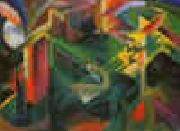 |
Franz Marc
|
|
1880-1916 German
Franz Marc Locations
Franz Marc was born in 1880, in the German town of Munich. His father, Wilhelm, was a professional landscape painter, and his mother Sophie was a strict Calvinist. He began study at the Academy of Fine Arts, Munich in 1900. In 1903 and 1907 he spent time in Paris and discovered a strong affinity for the work of Vincent van Gogh. Marc developed an important friendship with the artist August Macke in 1910. In 1911 he formed the Der Blaue Reiter artist circle with Macke, Wassily Kandinsky, and other artists who decided to split off from the Neue K??nstlervereinigung movement.
He showed several of his works in the first Der Blaue Reiter exhibition at the Thannhauser Galleries in Munich between December 1911 and January 1912. The exhibition was the apex of the German expressionist movement and also showed in Berlin, Köln, Hagen, and Frankfurt. In 1912, Marc also met Robert Delaunay, whose use of color and futurist method was a major influence on Marc's work. Marc became influenced by futurism and cubism, and his art became stark and abstract in nature.
His name was on a list of notable artists to be withdrawn from combat in World War I. Before the orders were carried out, he was struck in the head and killed instantly by a shell splinter during the Battle of Verdun (1916).
|
|
|
|
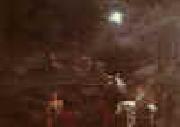 |
Franz Pforr
|
|
German
1788-1812
He received his earliest training from his father, the painter Johann Georg Pforr (1745-98), and his uncle, the art professor and first inspector of the painting gallery in Kassel, Johann Heinrich Tischbein the younger (1742-1808). In 1805 he became a student at the Akademie der Bildenden Kenste in Vienna, which was dominated by the severe Neo-classicism of its director, Heinrich Feger; he was taught by Hubert Maurer (1738-1818), Franz Cauzig (1762-1828) and Johann Martin Fischer. During the war with France in 1805, Pforr volunteered as a guard in the Vienna militia. He suffered a nervous breakdown, brought on by the conflict between his passionate longing for a contemplative life and a desire to see military action. He probably turned to religion to help sustain his mental equilibrium. In 1806 he resumed his academic studies and, believing himself destined to become a battle painter, made numerous drawings of historical battles, for example his still schoolish and baroquely composed Wallenstein in the Battle of L?tzen (1806; Frankfurt am Main, Stedel. Kstinst. & St?dt. Gal.). However, it was not until 1807, with Drawing with Twelve Travel Sketches (Frankfurt am Main, Stadt- & Ubib.), that he first began to overcome his beginner style and to develop his own. This resulted in reduced detail, simplified continuous contours, a structuring by means of planar rather than illusionistic criteria, a new clarity of vision and a chastened balance between nature and artistic conception.
|
|
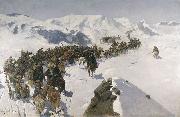 |
Franz Roubaud
|
|
was a Russian painter who created some of the largest and best known panoramic paintings.
Roubaud was born on 15 June 1856 in Odessa and attended an art school there. In 1877 he went to Munich, where he studied at the Munich Academy. He then settled in Saint Petersburg, working in the Imperial Academy of Arts and painting huge panorams of historical battles - Storm of Achulgo (1896, Tiflis, now under the restoration in the museun of graphic arts in Makhachkala), Siege of Sevastopol (1854) (unveiled in 1905, damaged during the Siege of Sevastopol (1942), restored in the 1950s), Battle of Borodino (1911, moved to Poklonnaya Hill in Moscow in 1962) and the Russo-Persian War (1804-1813). His works were so large that they had to be exhibited in pavilions specially built for that purpose. In 1913, Roubaud left Russia for Munich, where he died on 13 March 1928.
|
|
|
|
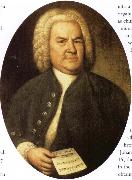 |
franz schubert
|
|
Period: Romantic (1820-1869)
Country: Austria
Born: January 31, 1797 in Vienna, Austria
Died: November 19, 1828 in Vienna, Austria
Genres: Chamber Music, Choral Music, Concerto, Keyboard Music, Miscellaneous Music, Opera, Orchestral Music, Symphony, Vocal Music |
|
|
|
|
|
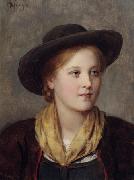 |
Franz von Defregger
|
|
(after 1883 Franz von Defregger) (30 April 1835 - 2 January 1921) was an Austrian artist known mostly for his genre and history paintings.
He was born in Ederhof at Stronach, in Tyrol, the son of a prosperous farmer. In 1860, following his father's death, Franz sold the family's farm and went to Innsbruck, where he studied with the sculptor Michael Stolz. He went to Munich in 1861 to study under Hermann Dyck and Hermann Anschetz. In 1863 he travelled to Paris, where he continued his artistic education autodidactically by a routine of figure drawing and a thorough study of the museums, art collections and studios. On 8 July 1865 he returned to Munich, where from 1867 to 1870 he studied alongside Hans Makart and Gabriel Max in the studio of history painter Karl von Piloty.
Defregger became one of the leading genre painters in Munich, and became a professor of history painting at the Munich Academy, where he continued to teach until 1910. He died in Munich in 1921. |
|
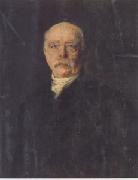 |
Franz von Lenbach
|
|
Shrobenhausen 1836-Munich 1904
German painter. The son of a master builder, he trained for his father's profession at the Kenigliche Landwirtschafts- und Gewerbeschule in Landshut, also working from 1851 in the sculpture studio of Anselm Sickinger (1807-73) in Munich. His elder brother, Karl August Lenbach (1828-47), had already become involved with painting, and it was through him that Franz Lenbach met Johann Baptist Hofner (1832-1913), an artist who had studied at the Akademie der Bildenden Kenste in Munich. They went on sketching expeditions together, and Hofner introduced him to plein-air painting. After spending two semesters at the Polytechnische Schule in Augsburg (1852-3), and some months in the studio of Albert Grefle (1807-89), a portrait painter in Munich, Lenbach entered the Akademie in Munich in 1854. In 1857 he attended the classes of Karl Theodor Piloty (later von Piloty), who was renowned for his history paintings. Lenbach produced his first important painting, the Angel Appearing to Hagar in the Desert (1858; destr.), while in this class, followed by Peasants Trying to Take Shelter from a Thunderstorm in a Chapel (1858; destr.; oil sketch, Schweinfurt, Samml. Schefer). The sale of this picture, together with a scholarship, enabled him to accompany Piloty on a journey to Rome with Ferdinand von Piloty (1828-95), |
|
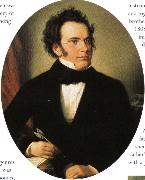 |
franz von schober
|
|
was a student in Vienna, where he met F. Schubert, E. Bauernfeld, and M. von Schwind. He is the author of twelve poems set to music by Schubert between 1815 and 1827, of which the best known is An die Musik (Du holde Kunst). In later life Schober was a secretary of legation (Legationsrat) in Weimar. |
|
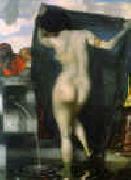 |
Franz von Stuck
|
|
German Symbolist/Expressionist Painter and Sculptor, 1863-1928
Stuck was born at Tettenweis, in Bavaria. From an early age he displayed an affinity for drawing and caricature. To begin his artistic education in 1878 he went to Munich, where he would settle for life. From 1881 to 1885 Stuck attended the Munich Academy.
He first made a name with cartoons for Fliegende Blätter, and vignette designs for programmes and book decoration. In 1889 he exhibited his first paintings at the Munich Glass Palace, winning a gold medal for The Guardian of Paradise.
In 1892 Stuck co-founded the Munich Secession, and also executed his first sculpture, Athlete. The following year he won further acclaim with the critical and public success of what is now his most famous work, The Sin. Also in 1893, Stuck was awarded a gold medal for painting at the Chicago World's Fair and was appointed to a royal professorship. In 1895 he began teaching painting at the Munich Academy.
In 1897 Stuck married an American widow, Mary Lindpainter, and began work designing his own residence and studio, the Villa Stuck. His designs for the villa included everything from layout to interior decorations; for his furniture Stuck received another gold medal at the 1900 Paris World Exposition.
Having attained a high degree of fame by this time, Stuck was elevated to the aristocracy on December 9, 1905 and would receive further public honours from around Europe during the remainder of his life. Even as new trends in art left Stuck behind, he continued to be highly respected among young artists in his capacity as professor at the Munich Academy. Notable students of his over the years include Paul Klee, Hans Purrmann, Wassily Kandinsky, and Josef Albers.
Franz von Stuck died in 1928; his funeral address memorialized him as "the last prince of art of Munich's great days". He is buried in the Munich Waldfriedhof next to his wife Mary. |
|
|
|
|
|
 |
Franz Xaver Winterhalter
|
|
German 1805-1873
Franz Xaver Winterhalter Galleries
German painter and lithographer. He trained as a draughtsman and lithographer in the workshop of Karl Ludwig Scheler (1785-1852) in Freiburg im Breisgau and went to Munich in 1823, sponsored by the industrialist Baron Eichtal. In 1825 he began a course of study at the Akademie and was granted a stipend by Ludwig I, Grand Duke of Baden. The theoretical approach to art of the Akademie under the direction of Peter Cornelius was unfamiliar to him, as in Freiburg he had been required to paint in a popular style. He found the stimulus for his future development in the studio of Joseph Stieler, a portrait painter who was much in demand and who derived inspiration from French painting. Winterhalter became his collaborator in 1825. From Stieler he learnt to make the heads of figures emerge from shadow and to use light in the modelling of faces. He moved to Karlsruhe in 1830 with his brother Hermann Winterhalter (1808-92), who had also trained with Scheler and had followed him to Munich. |
|
|
|
|
|
 |
Frederic Auguste Bartholdi
|
|
French Sculptor, 1834-1904,was a French sculptor. He is also known as Amilcar Hasenfratz, a pseudonym used for his paintings of Egyptian subjects, apparently because of concern that his work in another medium would distract from his sculpture. Born in Colmar, Alsace, Bartholdi went to Paris to further his studies in architecture as well as painting. Then he made a long trip to Egypt and Yemen, where he heard about the Suez project. He came back to his native city to become an architect. Bartholdi was a freemason, he was initiated on October 14, 1875 in the lodge LeAlsace-Lorraine, Grand Orient of France. |
|
|
|
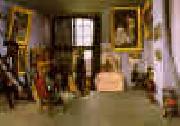 |
Frederic Bazille
|
|
b.Dec. 6, 1841, Montpellier, France
d.Nov. 28, 1870, Beaune-la-Rolande
French
Frederic Bazille Galleries
was a French Impressionist painter best known for his depiction of figures.
Born in Montpellier, Herault, Languedoc-Roussillon, into a middle-class Protestant family, Bazille became interested in painting after seeing some works of Eugene Delacroix. His family agreed to let him study painting, but only if he also studied medicine.
Bazille began studying medicine in 1859. He moved to Paris in 1862 to continue his studies. There he met Pierre-Auguste Renoir, was drawn to Impressionist painting, and began taking classes in Charles Gleyres studio. After failing his medical exam in 1864, he began painting full-time. His close friends included Claude Monet, Alfred Sisley, and Édouard Manet. Born to a wealthy family, Bazille helped support some of these artists by giving them space in his studio and materials to use.
Bazille was just twenty-three years old when he painted several famous works, including The Pink Dress. His best known painting is Family Reunion (1867?C1868). |
|
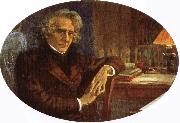 |
frederic chopin
|
|
Period: Romantic (1820-1869)
Country: Poland
Born: March 01, 1810 in Zelazowa Wola, Poland
Died: October 17, 1849 in Paris, France
Genres: Ballet, Chamber Music, Concerto, Keyboard Music, Miscellaneous Music, Vocal Music |
|
|
|
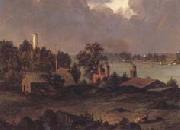 |
Frederic E.Church
|
|
1826-1900
American painter. He was a leading representative of the second generation of the HUDSON RIVER SCHOOL, who made an important contribution to American landscape painting in the 1850s and 1860s. The son of a wealthy and prominent businessman, he studied briefly in Hartford with two local artists, Alexander Hamilton Emmons (1816-84) and Benjamin Hutchins Coe (1799-1883). Thanks to the influence of the Hartford patron DANIEL WADSWORTH, in 1844 he became the first pupil accepted by Thomas Cole. |
|
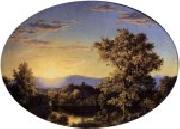 |
Frederic Edwin Church
|
|
American Hudson River School Painter, 1826-1900 ..American painter. He was a leading representative of the second generation of the HUDSON RIVER SCHOOL, who made an important contribution to American landscape painting in the 1850s and 1860s. The son of a wealthy and prominent businessman, he studied briefly in Hartford with two local artists, Alexander Hamilton Emmons (1816-84) and Benjamin Hutchins Coe (1799-1883). Thanks to the influence of the Hartford patron DANIEL WADSWORTH, in 1844 he became the first pupil accepted by Thomas Cole. This was an unusual honour |
|
|
|
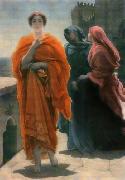 |
Frederic Leighton, 1st Baron Leighton
|
|
Frederic Leighton, 1st Baron Leighton PRA (3 December 1830 - 25 January 1896), known as Sir Frederic Leighton, Bt, between 1886 and 1896, was an English painter and sculptor. His works depicted historical, biblical and classical subject matter. Leighton was bearer of the shortest-lived peerage in history; after only one day his hereditary peerage ended with his death.
|
|
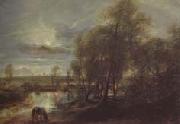 |
Frederic Remington
|
|
American Painter and Sculptor, 1861-1909
American painter, sculptor, illustrator and writer. In 1878 he began his studies at the newly formed School of the Fine Arts at Yale University in New Haven, CT, remaining there until 1880. This, along with a few months at the Art Students League in New York in 1886, was his only period of formal art training. In 1881 he roamed through the Dakotas, Montana, the Arizona Territory and Texas to document an era that was fast vanishing. He returned east and in 1882 had his first drawing published (25 Feb) in Harper's Weekly. Further commissions for illustrations followed, including that for Theodore Roosevelt's Ranch Life and the Hunting Trail (New York, 1888) (see BOOK ILLUSTRATION, fig. 8). |
|
|
|
 |
Frederic,lord leighton,p.r.a.,r.w.s
|
|
1830-1896
English painter and sculptor. He studied in Florence. His first exhibited picture, which showed Cimabue's Madonna being carried through the streets of Florence, was purchased by Queen Victoria in 1855. Leighton was president of the Royal Academy from 1878 until his death. |
|
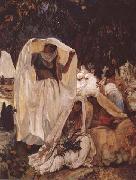 |
Frederick Arthur Bridgman
|
|
American Painter, 1847-1928
was an American artist, born in Tuskegee, Alabama. An American Southerner, born in Tuskeegee, Alabama, the son of a physician, Bridgman would become one of the United States' most well-known and well-regarded painters and become known as one of the world's most talented "Orientalist" painters. He began as a draughtsman in New York City, for the American Bank Note Company in 1864-1865, and studied art in the same years at the Brooklyn Art Association and at the National Academy of Design; but he went to Paris in 1866 and became a pupil of Jean-Leon Gerôme. Paris then became his headquarters. A trip to Egypt in 1873-1874 resulted in pictures of the East that attracted immediate attention, and his large and important composition, The Funeral Procession of a Mummy on the Nile, in the Paris Salon (1877), bought by James Gordon Bennett, brought him the Cross of the Legion of Honor. Other paintings by him were An American Circus in Normandy, Procession of the Bull Apis (now in the Corcoran Gallery of Art, Washington, D.C.), and a Rumanian Lady (in the Temple collection, Philadelphia, Pennsylvania). In 1867, Bridgman entered the studio of the noted academic painter Jean-Leon Gerôme (1824-1904), where he was deeply influenced by Gerôme's precise draftsmanship, smooth finishes, and concern for Middle-Eastern themes. (Bridgman would even become known as "the American Gerôme.") No mere imitator, however, Bridgman would later adopt a more naturalistic aesthetic, emphasizing bright colors and painterly brushwork. Bridgman made his first trip to North Africa between 1872 and 1874, dividing his time between Algeria and Egypt. There he executed approximately three hundred sketches, which became the source material for several later oil paintings. Additional visits to the region throughout the 1870s and 1880s allowed him to amass a collection of costumes, architectural pieces, and objets d'art, which often appear in his paintings. (Amusingly, John Singer Sargent noted that Bridgman's overstuffed studio, along with the Eiffel Tower, were Paris's must-see attractions.) Though Bridgman maintained a lifelong connection to France, his popularity in America never waned. Indeed, in 1890, the artist had a one-man show of over 400 pictures in New York's 5th Avenue galleries. When the show moved to Chicago's Art Institute, it contained only 300 works - testimony to the high number of sales Bridgman had made. |
|
|
|
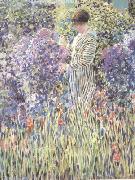 |
frederick carl frieseke
|
|
American Impressionist Painter, 1874-1939
was an American Impressionist painter. He was born in Owosso, Michigan and studied at the School of the Art Institute of Chicago and the Acad??mie Julian in Paris. Frieseke and his family resided for fourteen years in Giverny, which was also home to Monet. He had a great influence on the Americans at the colony there, |
|
|
|
 |
Frederick Edwin Church
|
|
1826-1900
Frederick Edwin Church Galleries
Frederic Edwin Church (May 4, 1826 ?C April 7, 1900) was an American landscape painter born in Hartford, Connecticut. He was a central figure in the Hudson River School of American landscape painters. While committed to the natural sciences, he was "always concerned with including a spiritual dimension in his works".
The family wealth came from Church's father, Joseph Church, a silversmith and watchmaker in Hartford, Connecticut.(Joseph subsequently also became an official and a director of The Aetna Life Insurance Company) Joseph, in turn, was the son of Samuel Church, who founded the first paper mill in Lee, Massachusetts in the Berkshires, and this allowed him(Frederic) to pursue his interest in art from a very early age. At eighteen years of age, Church became the pupil of Thomas Cole in Catskill, New York after Daniel Wadsworth, a family neighbor and founder of the Wadsworth Atheneum, introduced the two. In May 1848, Church was elected as the youngest Associate of the National Academy of Design and was promoted to Academician the following year. Soon after, he sold his first major work to Hartford's Wadsworth Atheneum.
Church settled in New York where he taught his first pupil, William James Stillman. From the spring to autumn each year Church would travel, often by foot, sketching. He returned each winter to paint and to sell his work.
Between 1853 and 1857, Church traveled in South America, financed by businessman Cyrus West Field, who wished to use Church's paintings to lure investors to his South American ventures. Church was inspired by the Prussian explorer Alexander von Humboldt's Cosmos and his exploration of the continent; Humboldt had challenged artists to portray the "physiognomy" of the Andes.
|
|
|
|
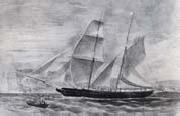 |
Frederick Garling
|
|
1775 - 1848,was an English attorney and solicitor, and was one of the first solicitors admitted in Australia and was regarded as the first senior solicitor of the second Supreme Court established in the colony of New South Wales, which is now a State of Australia. Garling is recognised as being one of the first crown solicitors in Australia. |
|
|
|
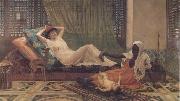 |
Frederick Goodall
|
|
British Painter, 1822-1904
Painter, son of Edward Goodall. He was taught by his father and first exhibited at the Royal Academy in 1838. His earliest subjects were rural genre scenes and landscapes, many derived from sketching trips made between 1838 and 1857 in Normandy, Brittany, Wales, Ireland, Scotland and Venice. In the 1850s he also painted subjects from British history. More significant for his subsequent career was his visit to Egypt from September 1858 to April 1859. In Cairo he lived in a house in the Coptic quarter with Carl Haag. Together the two artists went on expeditions to Giza to draw the Nile, the Sphinx and Pyramids, and to Suez and across the Red Sea to the Wells of Moses at 'Uyen Mesa. Goodall also made rapid sketches in the crowded streets of Cairo. 'My sole object in paying my first visit to Egypt', he wrote, 'was to paint Scriptural subjects'. The first of these, Early Morning in the Wilderness of Shur (London, Guildhall A.G.), was exhibited at the Royal Academy in 1860 and won him critical and popular acclaim. In 1864 he was elected RA. Much of the rest of Goodall's long career was devoted to painting similar scenes of Egyptian life with biblical associations, for which he made reference to his sketches and to Egyptian artefacts and clothing. Their success prompted a second visit to Egypt in 1870-71. |
|
|
|
Frederick Goodall,R.A
|
|
1822-1904
Painter, son of (1) Edward Goodall. He was taught by his father and first exhibited at the Royal Academy in 1838. His earliest subjects were rural genre scenes and landscapes, many derived from sketching trips made between 1838 and 1857 in Normandy, Brittany, Wales, Ireland, Scotland and Venice. In the 1850s he also painted subjects from British history. More significant for his subsequent career was his visit to Egypt from September 1858 to April 1859. In Cairo he lived in a house in the Coptic quarter with Carl Haag. Together the two artists went on expeditions to Giza to draw the Nile, the Sphinx and Pyramids, and to Suez and across the Red Sea to the Wells of Moses at 'Uy?n M?sa. Goodall also made rapid sketches in the crowded streets of Cairo. 'My sole object in paying my first visit to Egypt', he wrote, 'was to paint Scriptural subjects' (Reminiscences, p. 97). The first of these, Early Morning in the Wilderness of Shur (London, Guildhall A.G.), was exhibited at the Royal Academy in 1860 and won him critical and popular acclaim. In 1864 he was elected RA. Much of the rest of Goodall's long career was devoted to painting similar scenes of Egyptian life with biblical associations, for which he made reference to his sketches and to Egyptian artefacts and clothing. |
|
 |
Frederick goodall,R.A.
|
|
1822-1904
son of Edward Goodall. He was taught by his father and first exhibited at the Royal Academy in 1838. His earliest subjects were rural genre scenes and landscapes, many derived from sketching trips made between 1838 and 1857 in Normandy, Brittany, Wales, Ireland, Scotland and Venice. In the 1850s he also painted subjects from British history. More significant for his subsequent career was his visit to Egypt from September 1858 to April 1859. In Cairo he lived in a house in the Coptic quarter with Carl Haag. Together the two artists went on expeditions to Giza to draw the Nile, the Sphinx and Pyramids, and to Suez and across the Red Sea to the Wells of Moses at 'Uyen Mesa. Goodall also made rapid sketches in the crowded streets of Cairo. 'My sole object in paying my first visit to Egypt', he wrote, 'was to paint Scriptural subjects'. The first of these, Early Morning in the Wilderness of Shur (London, Guildhall A.G.), was exhibited at the Royal Academy in 1860 and won him critical and popular acclaim. In 1864 he was elected RA. Much of the rest of Goodall's long career was devoted to painting similar scenes of Egyptian life with biblical associations, for which he made reference to his sketches and to Egyptian artefacts and clothing. Their success prompted a second visit to Egypt in 1870-71. |
|
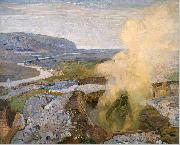 |
Frederick Horsman Varley
|
|
(January 2, 1881 - September 8, 1969), was a member of the Canadian Group of Seven artists.
Varley was born in Sheffield, England. He studied art in Sheffield and in Belgium. He came to Canada in 1912 on the advice of another Sheffield native (and future Group of Seven member), Arthur Lismer, and found work at the Grip Ltd. design firm in Toronto, Ontario.
|
|
|
|
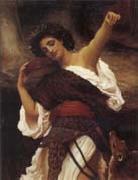 |
Frederick Leighton
|
|
1830-1896
He was an English painter and sculptor. His works depicted historical, biblical and classical subject matter. Leighton was born in Scarborough to a family in the import and export business. He was educated at University College School, London. He then received his artistic training on the European continent, first from Eduard Von Steinle and then from Giovanni Costa. When in Florence, aged 24, where he studied at the Accademia di Belle Arti, he painted the procession of the Cimabue Madonna through the Borgo Allegri. He lived in Paris from 1855 to 1859, where he met Ingres, Delacroix, Corot and Millet. Flaming JuneIn 1860, he moved to London, where he associated with the Pre-Raphaelites. He designed Elizabeth Barrett Browning's tomb for Robert Browning in the English Cemetery, Florence in 1861. In 1864 he became an associate of the Royal Academy and in 1878 he became its President (1878?C96). His 1877 sculpture, Athlete Wrestling with a Python, was considered at its time to inaugurate a renaissance in contemporary British sculpture, referred to as the New Sculpture. His paintings represented Britain at the great 1900 Paris Exhibition. Icarus and DaedalusLeighton was knighted at Windsor in 1878, and was created a baronet eight years later. He was the first painter to be given a peerage, in the New Year Honours List of 1896. |
|
|
|
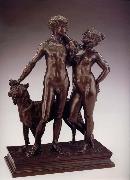 |
Frederick Macmonnies
|
|
American Sculpture 1863-1937,American sculptor and painter. During his apprenticeship in New York (1880-84) with Augustus Saint-Gaudens, who discovered and encouraged his talent, he rose from menial helper to assistant, studying in the evenings at Cooper Union and the National Academy of Design. Through Saint-Gaudens he met two architects who later became invaluable colleagues: Stanford White and Charles F. McKim, who lent him money in 1884 to go to Paris. He studied drawing at Colarossi's then went to Munich, attending drawing and portrait classes at the Akademie (1884-5) and worked for Saint-Gaudens again (1885-6). In Paris he studied sculpture with Alexandre Falguiere at the Ecole des Beaux-Arts, |
|
 |
Frederick Mccubbin
|
|
Australian Painter, 1855-1917
By the early 1880s, his work began to attract considerable attention and won a number of prizes from the National Gallery, including a 30-pound first prize in 1883 in their annual student exhibition, and by the mid-1880s began to concentrate more on the works of the Australian bush which made him most famous. In 1883, he received first prize in the first annual Gallery students' exhibition, for best studies in colour and drawing. In 1888, he became instructor and master of the School of Design at the National Gallery. In this position he taught a number of students who themselves became prominent Australian artists, including Charles Conder and Arthur Streeton. He continued to paint through the first two decades of the 20th century, though by the beginning of World War I his health began to fail. He travelled to England in 1907 and visited Tasmania, but aside from these relatively short excursions lived most of his life in Melbourne. McCubbin married Annie Moriarty in March, 1889. They had seven children, of whom their son Louis also became an artist. In 1901 McCubbin and his family moved to Mount Macedon, where he was inspired by the surrounding bush and has experimented with the light and its effects on colour in nature. In 1912, |
|
|
|
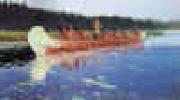 |
Frederick Remington
|
|
1861-1909
Frederic Sackrider Remington (October 4, 1861 - December 26, 1909) was an American painter, illustrator, sculptor, and writer who specialized in depictions of the Old American West, specifically concentrating on the last quarter of the 19th century American West and images of cowboys, American Indians, and the U.S. Cavalry.
Remington was the most successful Western illustrator in the ??Golden Age?? of illustration at the end of the 19th Century and the beginning of the 20th Century, so much so that the other Western artists such as Charles Russell and Charles Schreyvogel were known during Remington??s life as members of the ??School of Remington??. His style was naturalistic, sometimes impressionistic, and usually veered away from the ethnographic realism of earlier Western artists such as George Catlin. His focus was firmly on the people and animals of the West, with landscape usually of secondary importance, unlike the members and descendants of the Hudson River School, such as Frederic Edwin Church, Albert Bierstadt, and Thomas Moran, who glorified the vastness of the West and the dominance of nature over man. He took artistic liberties in his depictions of human action, and for the sake of his readers?? and publishers?? interest. Though always confident in his subject matter, Remington was less sure about his colors, and critics often harped on his palette, but his lack of confidence drove him to experiment and produce a great variety of effects, some very true to nature and some imagined.
His collaboration with Owen Wister on The Evolution of the Cowpuncher, published by Harper??s Monthly in September 1893, was the first statement of the mythical cowboy in American literature, spawning the entire genre of Western fiction, films, and theater that followed. Remington provided the concept of the project, its factual content, and its illustrations and Wister supplied the stories, sometimes altering Remington??s ideas. (Remington??s prototype cowboys were Mexican rancheros but Wister made the American cowboys descendants of Saxons??in truth, they were both partially right, as the first American cowboys were both the ranchers who tended the cattle and horses of the American Revolutionary army on Long Island and the Mexicans who ranched in the Arizona and California territories). |
|
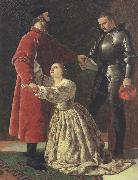 |
Frederick richard pickersgill,R.A.
|
|
1820-1900
was an English painter and book illustrator. Born into a family of artists, he was admitted to the Royal Academy Schools in 1840. He did some book illustrations for the works of John Milton and Edgar Allan Poe. Pickersgill's The Burial of Harold was accepted as a decoration for the Houses of Parliament in 1847. He also did some landscapes under the influence of the Pre-Raphaelites. In 1856 Pickersgill was photographed at 'The Photographed Institute' by Robert Howlett, as part of a series of portraits of 'fine artists'. |
|
 |
Frederick Sandys
|
|
English Pre-Raphaelite Painter, ca.1829-1904
English painter, illustrator and draughtsman. He was the son of Anthony Sands (1804-83), a minor local artist. He began his artistic education with his father and attended the Norwich School of Design from 1846. His precocious talent was recognized by the award of silver medals by the Society of Arts in 1846 and 1847. He moved to London in 1851, when he first exhibited at the Royal Academy, but he continued to spend time at Norwich until the death of his parents in 1883. After publishing in 1857 A Nightmare, a gentle caricature of John Ruskin and his Pre-Raphaelite proteg's William Holman Hunt, John Everett Millais and Dante Gabriel Rossetti and based on Millais's Sir Isumbras at the Ford |
|
|

